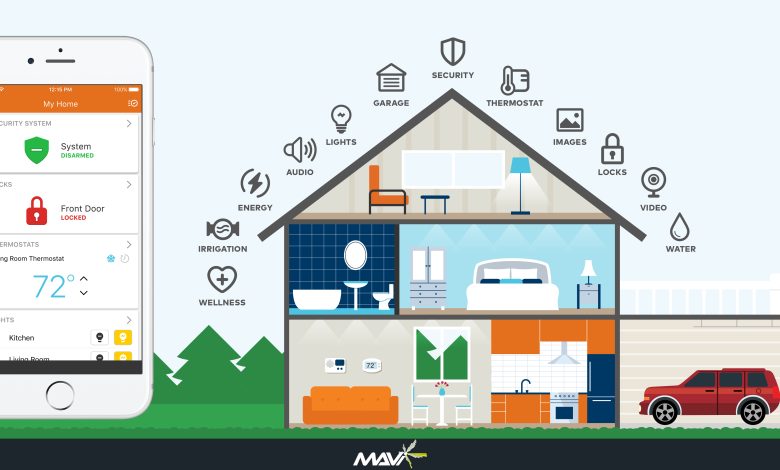Everything You Need to Know About Smart Home Automation

What is Smart Home Automation?
When you use technology to automate your home, it’s called “Smart Home Automation.” With the Internet of Things, you can control every part of your home with home automation.
Since the invention of the thermostat, home automation has evolved to become one of the largest and fastest-growing technical markets. Home automation’s potential continues to expand. It can use for home security, appliance management, energy monitoring, personal assistant, elderly or handicapped care, and more.
You will discover all you need to know about Home Automation in this tutorial. Not just how it works, but also the many applications and drawbacks. You’ll also discover numerous useful links to new Smart-Home items, just in case you come across something you didn’t realize you were missing.
What is the Process of Home Automation?
It is difficult to describe how it works because there is no general standard for a home tool, it is difficult to describe how it works.
The technology employed varies depending on the country, company, and type of automation. Because the Home-Automation market is so profitable and fast-paced, companies frequently keep significant discoveries hidden.
Industry standards for home automation rely more significantly on modern wireless technology, such as mesh networking. All of these systems are quite difficult to grasp. Simply put, they send and receive messages using energy, radio waves, and wireless technologies.
Central Control:
Central control is a single Home-Automation system that manages everything in your house. It lets you operate your lights, thermostat, sprinklers, phone, washer, dryer, and other appliances from a single location. The most typical users of this type of home automation are businesses and affluent individuals’ homes. It’s also very frequent with home automation security systems.
Usually, Central Control systems are controlled using a wall-mounted console, similar to those used in home security systems. A remote control device, smartphone, tablet, or computer can also be used to access them.
Pros:
A central control system’s name is an advantage in and of itself. A single unified system may control all aspects of your home. Everything can be controlled from a single spot, from your shower to your home security system. Central control systems are also reasonably priced, indicating that they are of high quality.
Cons:
These systems are typically more costly and require professional installation. More consumers are choosing app-based automation that may be used in conjunction with Smart Hubs to emulate Central Control systems as the popularity of home automation grows. Another issue with these systems is how inclusive they are. When you go with a central system, you’re usually limited to the gadgets that work with it. If you buy a new washing machine, for example, you will be limited to the machines used in that machine.
Many systems are adjusting to the home automation industry by becoming more interoperable with developing technologies as time goes on.
App-based:
App-based Smart-Home technology communicates with the Cloud via your home network. Cloud technology is an important component of the Internet of Things, and both have become increasingly popular in recent years. The majority of app-based smart devices work by connecting them to your home network via Wi-Fi. Those gadgets connect to a central server, which you can then access via apps on your smartphone.
You can coordinate with your Smart Home devices once you’ve registered a personalized account using these applications. This allows the organization to identify which device corresponds to which app user.
Bluetooth is used by some app-based home automation devices to connect directly to your smart smartphone. Similar to cloud-based home automation, you’ll need to create a personal account on the app. Unlike cloud-based apps, these home-automation devices require you to be in close proximity to them in order to operate.
Pros:
App-based Home Automation is undoubtedly responsible for the general public’s access to Smart-Homes. Many people are building DIY Smart homes since these gadgets are inexpensive, simple to install, use, and update.
Cons:
Unlike Central Control, most cloud-based Home Animation Smart-Homes necessitate the use of multiple apps. Some smart home automation platforms offer multiple functions that can access through a single app. Developers, on the other hand, are already working on gadgets that resemble Central Control systems.
How to Choose Smart Home Automation System
For many homeowners, home automation is the next frontier. Most systems on the market a few years ago were difficult to operate, costly, and meant primarily for extremely big homes. Modern systems, on the other hand, are easier to use, more cost-effective, and programmed to control either a home entertainment system or all of the home’s electrical components.
You can remotely operate your house from anywhere with your smartphone, lowering your home energy expenditures in the process.
Flexibility
Flexibility is the most important feature to look for in a home automation system. MAVi home automation systems, for example, work well with a number of security systems to tightly integrate automation features with systems you may already possess.
Control
Homeowners may save money by altering their house’s temperature, controlling lights remotely, activating home security, and other methods. Installing a high-end system pays well. Those on the low end of the market are more likely to make savings by omitting the finer control required to improve the most crucial aspects of home automation.
Variety
Most people aren’t seeking a light switch on their keychain, though. They want to be able to use the same system to manage motorized blinds, air conditioning and heating, and home security in both their primary and secondary houses.
Complete Control at Your Fingertips
Low-cost solutions simply cannot fulfill all of your requirements. Homeowners frequently end up cobbling together a system that includes a smart thermostat from one vendor, smart lights from another, and home monitoring from a third. They end up with a jumble of sensors, applications, and technologies that don’t operate well together or even communicate. High-end systems provide everything you need and can readily expand to meet your changing demands.
Communication
Low-cost systems scrimp on technology and software, making your “smart” house a little less clever than it should be. For example, a Savant system will recognize that you want your home to be at a certain temperature and convey that instruction to all connected components, such as the thermostat and blinds, saving you money and reducing the load on your climate control system.
Home automation entails connecting all of your electronic components and ensuring that they interact with one another at the appropriate times. With a high-end home automation system, you can rest assured that your smart home has advanced to the next level in terms of convenience and cost savings.
Set Up Your Smart Home Today with MAVi
MAVi is committed to offering the best Kansas home automation service with excellent client service, high-quality work, and meticulous attention to detail. Whether you need television, projector, or phone system installed, we are committed to providing you and your family with top-of-the-line items. Customers return to us time and time again because of our unrivaled customer service and efficiency.
Click Here To Know: What are smart buildings: An ultimate guide.





